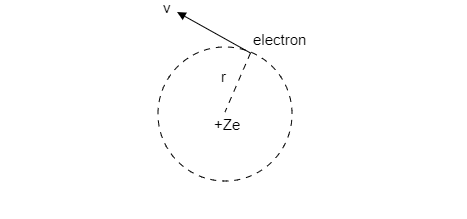
The minimum magnetic dipole moment of an electron in the hydrogen atom is
A)
B)
C)
D)
Answer
139.8k+ views
Hint: The electron revolving around the nucleus in an orbit of radius
Formula Used:
1. Current
2. Relation between linear velocity
3. Magnetic dipole moment is
Angular momentum of an electron of mass
4. From Bohr’s postulate we have,
Complete step by step answer:
Step1: Sketch a schematic diagram of the electron in the hydrogen atom.

Step 2: Express the relation for the current generated by the revolving electron.
Substitute
Step 3: Express the relation for magnetic dipole moment of the electron in the hydrogen atom.
Magnetic dipole moment
Step 4: Express the magnetic dipole moment
Step 5: Use Bohr’s postulate about angular momentum to obtain the minimum magnetic dipole moment of the electron in the hydrogen atom.
Note: : It is important to evaluate the options in which quantities the final answer is expressed and hence then manipulate equations to reach to the final answer in the quantities displayed in the option.
Formula Used:
1. Current
2. Relation between linear velocity
3. Magnetic dipole moment is
Angular momentum of an electron of mass
4. From Bohr’s postulate we have,
Complete step by step answer:
Step1: Sketch a schematic diagram of the electron in the hydrogen atom.

Step 2: Express the relation for the current generated by the revolving electron.
The electron revolving around the nucleus of the hydrogen atom is like the current flowing through a current carrying loop that encompasses an area
So, the current generated by an electron of charge
Substitute
Substituting for
Step 3: Express the relation for magnetic dipole moment of the electron in the hydrogen atom.
Magnetic dipole moment
The area of the orbit (or loop) along which the electron revolves is given by,
Now substitute for
We have,
Simplifying we get,
Step 4: Express the magnetic dipole moment
Angular momentum of a mass
i.e.,
Substituting the above relation in the equation
Step 5: Use Bohr’s postulate about angular momentum to obtain the minimum magnetic dipole moment of the electron in the hydrogen atom.
According to Bohr’s atomic model, the angular momentum of the electron orbiting around the nucleus is quantized. The angular momentum of an electron is given by,
Substitute
For minimum magnetic dipole moment,
Therefore, the correct option is b)
Note: : It is important to evaluate the options in which quantities the final answer is expressed and hence then manipulate equations to reach to the final answer in the quantities displayed in the option.
Latest Vedantu courses for you
Grade 10 | MAHARASHTRABOARD | SCHOOL | English
Vedantu 10 Maharashtra Pro Lite (2025-26)
School Full course for MAHARASHTRABOARD students
₹31,500 per year
EMI starts from ₹2,625 per month
Recently Updated Pages
Average fee range for JEE coaching in India- Complete Details

Difference Between Rows and Columns: JEE Main 2024

Difference Between Length and Height: JEE Main 2024

Difference Between Natural and Whole Numbers: JEE Main 2024

Algebraic Formula

Difference Between Constants and Variables: JEE Main 2024

Trending doubts
JEE Main 2025 Session 2: Application Form (Out), Exam Dates (Released), Eligibility, & More

JEE Main 2025: Derivation of Equation of Trajectory in Physics

A point charge + 20mu C is at a distance 6cm directly class 12 physics JEE_Main

JEE Main Exam Marking Scheme: Detailed Breakdown of Marks and Negative Marking

Learn About Angle Of Deviation In Prism: JEE Main Physics 2025

Electric Field Due to Uniformly Charged Ring for JEE Main 2025 - Formula and Derivation

Other Pages
JEE Advanced Marks vs Ranks 2025: Understanding Category-wise Qualifying Marks and Previous Year Cut-offs

JEE Main 2025: Conversion of Galvanometer Into Ammeter And Voltmeter in Physics

Degree of Dissociation and Its Formula With Solved Example for JEE

Electric field due to uniformly charged sphere class 12 physics JEE_Main

Dual Nature of Radiation and Matter Class 12 Notes: CBSE Physics Chapter 11

Formula for number of images formed by two plane mirrors class 12 physics JEE_Main




